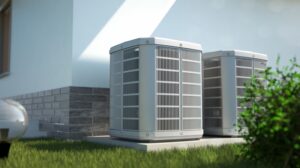Heat pumps are versatile HVAC systems designed to provide both heating and cooling, making them essential for year-round comfort in Oakland, CA. However, encountering a situation where your heat pump won’t switch to cooling mode can be puzzling and frustrating, especially when you need relief from the heat. It might have you looking for HVAC repair in Oakland. If you’re still evaluating your options, see how to choose between a heat pump or central AC to ensure you’ve selected the right system for your needs.
Thermostat Settings or Malfunctions
One possible issue is that you have the thermostat on the wrong settings which could be preventing the heat pump from switching to cooling mode. If the thermostat is set to heating or another mode, the heat pump will continue to operate in that mode. Double-check your thermostat settings. Make sure it’s set to the cooling mode and the desired temperature. If needed, try resetting the thermostat to its default settings.
If it’s a malfunction, the thermostat might not be sending the correct signals to your heat pump to switch modes. You can test the thermostat by adjusting the temperature settings. If it’s unresponsive or shows erratic behavior you might want to consider calibrating or replacing it.
Reversing Valve Issues
This component is responsible for changing the direction of refrigerant flow. This allows the heat pump to switch between heating and cooling modes. If the reversing valve is stuck or malfunctioning the heat pump might not be able to switch to cooling. In order to correct this problem you’ll need professional help.
Low Refrigerant Levels
When levels are low it can have a large impact on the performance of your heat pump. Refrigerant is a vital component in the heat pump cycle. It plays a central role in the heat transfer process that enables the heat pump to provide both heating and cooling.
Refrigerant is responsible for absorbing heat from the indoor air during the heating mode and releasing heat outdoors during the cooling mode. When refrigerant levels are low due to a leak in the system, the heat transfer process becomes less efficient. The heat pump will struggle to extract and release heat efficiently, leading to higher energy consumption and elevated utility bills. For more insight into sustainable HVAC solutions, check out how heat pumps can curb emissions and save money. The heat pump has to work harder and longer to achieve the desired indoor temperature. This increased workload translates into higher energy consumption, leading to elevated utility bills.
Outdoor Unit Problems
Issues with the outdoor unit such as a faulty control board or sensor can prevent the heat pump from switching to cooling mode. If your system is aging or facing frequent breakdowns, it might be time to learn about the benefits of installing a new heat pump to improve comfort and energy efficiency in the long run. You can inspect the outdoor unit for any visible damage or issues. If everything appears normal but the cooling mode still won’t engage, schedule a professional inspection and repair.
A heat pump’s inability to switch to cooling mode can stem from various factors, ranging from thermostat issues to mechanical problems within the system. Troubleshooting and addressing these issues promptly are essential to restore your heat pump’s proper functioning and ensure your comfort during warmer months.
Contact Comfy Heating & Air Conditioning Inc. today to schedule your appointment!

